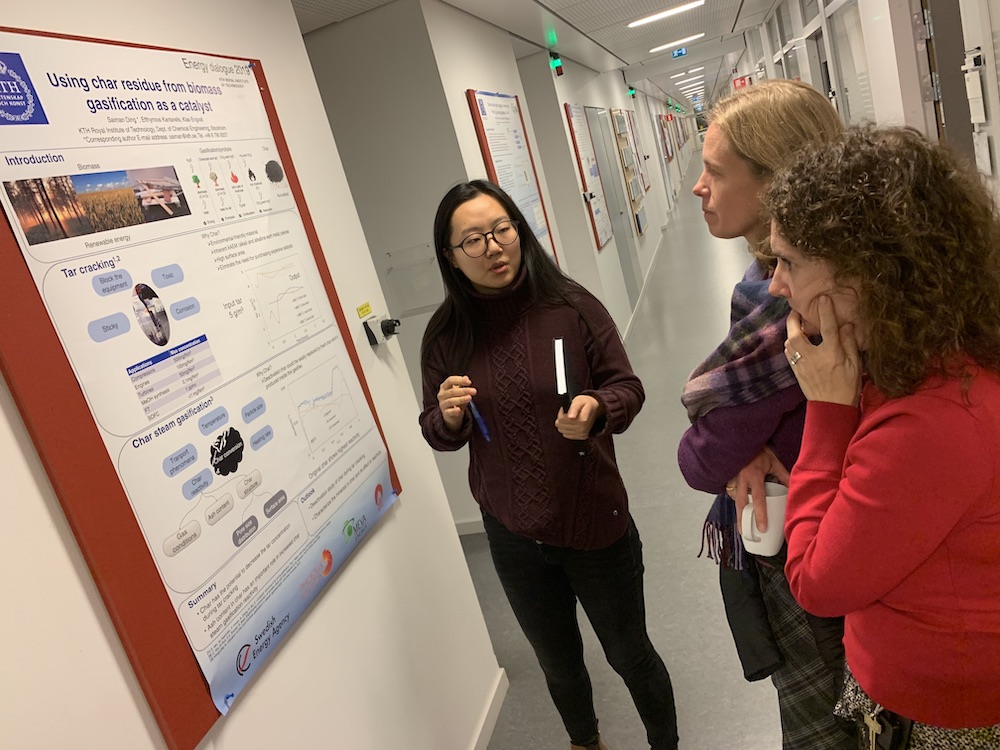Chemistry research behind new methods for sustainable energy
School visit, Energy Platform, School of Engineering Sciences in Chemistry, Biotechnology and Health

The Energy Platform's visit to the School of Engineering Sciences in Chemistry, Biotechnology and Health was made at the Department of Chemical Engineering. Here, there was a meeting of a large group of researchers with presentations on everything from fuel cells and biogas to gasification and hydrogen-based steel production.
Carina Lagergren, Head of Department and Professor of Chemical Engineering, welcomed the Energy Platform by providing an overview of the activities of the Department of Chemical Engineering. The department accommodated six divisions: Energy Processes, Process Technology, Nuclear Waste Technology, Resource Recovery, Technical Fluid Mechanics and Applied Electrochemistry. A total of approximately 75 people work here, including nine professors and approximately 40 doctoral students.
"A large part of out research is energy-related and has a bearing on sustainable development and the environment", says Carina Lagergren.
The first presentation was given by doctoral student Joakim Andersson. He works within the Hybrit (Hydrogen Breakthrough Ironmaking Technology) national steel project, which shall lead to fossil-free steel production. The project is managed by SSAB, LKAB and Vattenfall with the support of the Swedish Energy Agency.
"Cement production, the aviation industry and steelmaking are all sources of major carbon dioxide emissions in Sweden. Hybrit has the potential to reduce Sweden's carbon dioxide emissions by 10- 11 per cent", says Joakim Andersson.
Steelmaking is currently responsible for significant production of carbon dioxide. Every tonne of steel produced today results in the production of 1.6 tonnes of carbon dioxide. Hybrid aims to replace the blast furnaces of today with another type of furnace where hydrogen is used instead of coal. Using the new method can reduce the amount of carbon dioxide per tonne of steel to as little as 25 kilograms.
"It will make a huge difference, but also require changes in the entire steelmaking process. In addition, the hydrogen method will need a lot more electricity than today's method", says Joakim Andersson.
The hydrogen-based method can be implemented industrially in 2040-2045, when the price of electricity is estimated to be considerably lower than at present. Profitability can also therefore be better maintained in production. The department's contribution to the project includes research on the production and storage of hydrogen in order to make these aspects as cost-effective as possible. Other parts of KTH also contribute with material design for the new furnaces, among other things.
The next step was a round tour with visits to the various laboratories. Among other things, this gave an insight into ongoing research in order to minimise tar during biomass gasification. Tar is a by-product that is both toxic and corrosive. The project uses biochar, among other things, as a catalyst in order to create reactions that reduce the tar. Various additives of oxygen and hydrogen can also reduce the tar. The aim is to find the right combinations for creating new industrial applications.
In one specific project, research is being carried out with the aim of increasing the quality of the gas produced. A pilot reactor has produced good results, with a very low production of tar, good gas quality, as well as low production of soot.
Also on display here was research into fuel cells, among other things, with new catalysts and different forms of membranes for the cells. Another project dealt with producing fuel cells for use in an underwater environment, such as in research submarines navigating under the Arctic ice. As well as projects to use fuel cells to separate different gases, such as carbon dioxide, with more control than at present.
During the visit, a large number of researchers participated in a range of fields, such as energy recovery from biomass, gas production, surface chemistry for catalysis processes, electrolysis, hydrogen production, emission control, batteries and fuel cells.
The Energy Platform was represented by Director, Lina Bertling Tjernberg, Vice Director, Christophe Duwig, and Cecilia Sundberg, member of the platform's reference group.
Text: Magnus Trogen Pahlén
